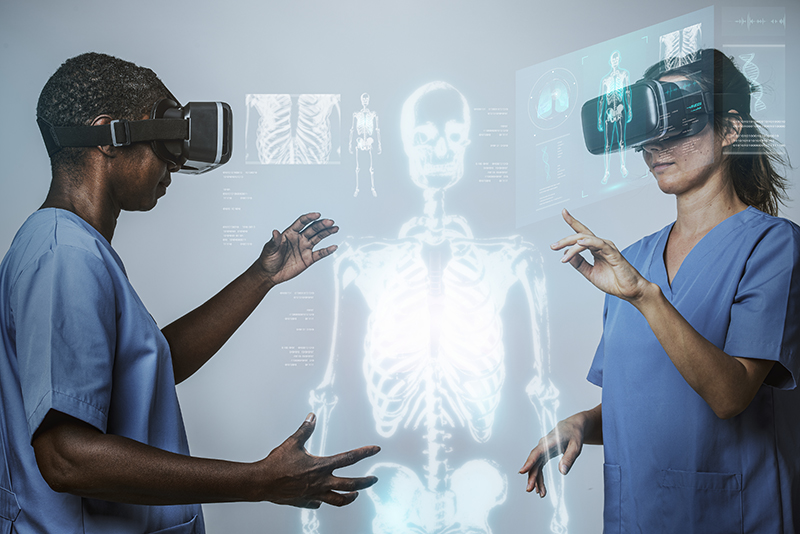In the healthcare sector, artificial intelligence (AI) and virtual reality (VR) are being used to develop more accurate and efficient ways to diagnose and treat medical conditions, providing patients with better care and improved outcomes. With the increasing use of AI and VR in healthcare, the American Medical Association unveiled new Current Procedural Terminology (CPT) codes for these services. Adoption and integration of these technologies help to enhance various aspects of medical practice, patient care, and research. An experienced medical coding company will be up to date with these codes.
AI is being used to develop algorithms that can analyze medical images, such as X-rays and CT scans, to detect and diagnose diseases. AI-powered systems can also be used to identify patterns in patient data, such as symptoms and lab results, to help doctors make more accurate diagnoses. AI can also be used to develop personalized treatments based on a patient’s individual characteristics and medical history.
VR is being used to provide immersive training experiences for medical professionals. VR can be used to simulate medical procedures, allowing doctors to practice and perfect their skills in a safe and controlled environment. VR can also be used to provide virtual reality-based treatments for conditions such as anxiety and phobias.
AI and VR are also being used to improve patient care. AI-powered chatbots can be used to provide patients with personalized advice and support, while VR can be used to provide virtual tours of medical facilities and virtual consultations with doctors.

Improve your coding accuracy and maximize your reimbursement with us!
Contact us at (800) 670 2809
Read more on our Medical Coding Services!
CPT Code Set for AI- and VR-assisted Therapies
Artificial intelligence
- 0731T to report AI facial phenotypic analysis
- 0740T and 0741 to report AI insulin titration
- 0764T and 0765T to report AI cardiac function services
- 0777T to report AI-assisted epidural placement
Facial phenotypic analysis utilizes the process of uploading photographs, typically of infants and children, to a database containing images of patients with genetic malformations or syndromes. This analysis aims to aid in the diagnosis by identifying potential genetic causes for the patient’s symptoms and signs.
In the case of insulin titration, an AI algorithm, in collaboration with the patient’s physician, employs a sample from a patient diagnosed with type 2 diabetes to determine an optimal dosage recommendation for achieving effective glucose control. This AI-driven approach offers a personalized and precise method for adjusting insulin levels, thereby improving the management of the patient’s diabetes.
Virtual Reality
- 0770T to report VR-mediated therapy
- 0771T to 0774T to report VR procedural dissociation services
The add-on code, 0770T, encompasses the costs associated with software commonly utilized in VR-mediated therapy. This therapy focuses on enhancing social communication skills, emotional regulation, and daily functional abilities in individuals with neurodevelopmental and mental health disorders like autism spectrum disorder. By using this code, healthcare providers can appropriately bill for the expenses related to the software used in these therapeutic interventions.
The codes 0771T-0774T cover the application of computer-generated VR technology in creating an immersive audiovisual environment, which is specifically designed to modify a patient’s perception of pain, allowing for a reduction in the need for higher levels of sedation. This approach enables patients to remain responsive to verbal commands and external stimuli while managing their pain levels effectively. These codes help to accurately document and bill for these VR-based pain management techniques.
The AI taxonomy offers a framework to categorize different AI-driven medical service applications, including machine learning or algorithm-based solutions, into three distinct categories:
- Assistive: In this category, the machine identifies clinically relevant data without performing any analysis or generating conclusions. Physician interpretation or input is necessary to make sense of the identified data and derive meaningful insights.
- Augmentative: Applications falling into this category involve the machine analyzing or quantifying data in a clinically significant manner. However, the interpretation of the analyzed data still requires the involvement of a physician or another qualified healthcare professional. The machine provides additional insights or support, but the final decision-making rests with the healthcare provider.
- Autonomous: The autonomous category encompasses applications where the machine independently interprets data and generates clinically meaningful conclusions without the direct involvement of a physician. The machine has the capability to analyze and draw insights from the data, providing conclusions that can guide decision-making in healthcare settings.
By classifying AI-powered medical services into these three categories, the AI taxonomy helps to clarify the level of machine involvement and the extent of physician input required at each stage of data analysis and decision-making.
AI Applications in Healthcare
In healthcare, AI is being used in several ways:
- Medical imaging: AI algorithms can analyze medical images, such as X-rays, CT scans, and MRIs, to assist radiologists in diagnosing diseases and identifying abnormalities. AI can help detect early signs of diseases, improve accuracy, and speed up the diagnosis process.
- Personalized medicine: AI can analyze large datasets of patient information, including genetic and clinical data, to identify patterns and provide personalized treatment recommendations. This approach can assist in tailoring treatment plans and predicting patient outcomes.
- Drug discovery: AI can aid in the discovery and development of new drugs by analyzing vast amounts of data, such as genomic information and chemical properties. It can help identify potential drug candidates, predict their efficacy and side effects, and accelerate the research process.
- Virtual assistants: AI-powered virtual assistants or chatbots can provide basic medical information, answer patient queries, and assist with appointment scheduling. They can offer 24/7 support, reducing the burden on the healthcare staff and improving patient experience.
- Virtual reality, on the other hand, refers to the use of computer-generated environments that simulate real or imagined experiences. In healthcare, VR is finding applications in various areas:
- Pain management: VR technology can create immersive and interactive environments that help distract patients from pain and discomfort during medical procedures or rehabilitation exercises. It has shown effectiveness in reducing pain and anxiety.
- Surgical training and planning: VR enables surgeons to practice complex procedures in a simulated environment, improving their skills and reducing the risk during real surgeries. It also allows for pre-operative planning by visualizing patient-specific anatomy.
- Mental health therapy: VR can be used as a tool in psychological therapies by creating controlled environments to expose patients to anxiety-inducing situations or phobias. It helps in treating conditions like post-traumatic stress disorder (PTSD) and anxiety disorders.
- Rehabilitation: VR-based rehabilitation programs can provide interactive and engaging exercises for patients recovering from physical injuries or neurological conditions. It can assist in improving motor skills, balance, and cognitive functions.
- Assistance: AI-powered chatbots are revolutionizing the healthcare industry by providing accessible and reliable basic medical advice and triage services. Virtual reality (VR) technology has the potential to enhance healthcare accessibility by enabling remote consultations with specialists.
Medical coding services provided by reliable companies are designed to seamlessly integrate these innovative modalities into the healthcare system, ensuring proper documentation, billing, and reimbursement for AI and VR-assisted procedures. They will have a team of highly skilled and experienced medical coders, specialized in accurately documenting and assigning the appropriate codes for AI and VR-enhanced medical therapies.

Experience the difference with our top-tier medical coding services!
We help to streamline your coding and billing processes.
Get a Free Trial Today


